Photographing your art doesn’t have to be difficult, costly, or time consuming. Charley Freiberg, commercial photographer, shared many helpful tips with us last year for our Artist to Artist program. Check them out, and keep your eyes peeled for more workshops with Charley!
General Tips:
Handy Things to have around: You can use anything available to you to assist you in capturing the perfect image, much of which is available at your local craft store. Recommended items include a Styrofoam board, clothespins, Ripstop nylon, dulling spray, Pionite (color: Bankers Grey), tape, paper, and lights.
Light bulbs used: Overdrive Energy Saving Lamps 105W Full light spectrum spiral CFL
Camera settings: Always set your camera to Manual mode and avoid using any pre-programmed settings. These settings make photos look unrealistic. Always shoot at the maximum resolution and minimum ISO that your camera is capable of. That means you'll need to use a tripod.
Tips:
- Do not trust your camera screen in regards to color! Camera screens are generally only good for judging how light or dark the image is.
- Be consistent with your set-up. Do it exactly the same way every time and make markers to avoid wasting time during your next photo-shoot.
- Shooting a piece of art vertically or horizontally does not matter. You can rotate the image in a photo-editing program or on your camera at a later time.
- Try to view your artwork with the perspective of a consumer (if that is your goal of photographing your work). What may be the ‘best side’ to the artist might be the ‘worst side’ to the consumer.
Photographing 2D Art:
Location: Place your art against a wall, or hang it, so that it is flush with the wall's surface.
Lighting: Place two lights at a 45 degree angle from either side of the artwork. If the shadows are the same size on each side of the artwork, your lights are even. Generally, you want all of the area surrounding the artwork to be lighted evenly.
Tips: The closer the lights are to the artwork at a 45 degree angle, the more exposed oils, wet paints, or glitters will be. The closer the lights are to the artwork at a larger angle (90 degrees), the less exposed oils, wet paints or glitters will be.
Photographing 3D Art:
Lighting - Top light: One light fixture above the piece is ideal. The human brain likes softer shadows. This can be accomplished by placing the edge of the light fixture directly in front of the object below it.
Location: Place the item on a table top or surface away from a wall. To set a plain back ground hang a sheet or large piece of paper 18-24" behind the item.
Tips: Use Dulling Spray ($10-$15 at any art supply store) to reduce the shine of an object.
